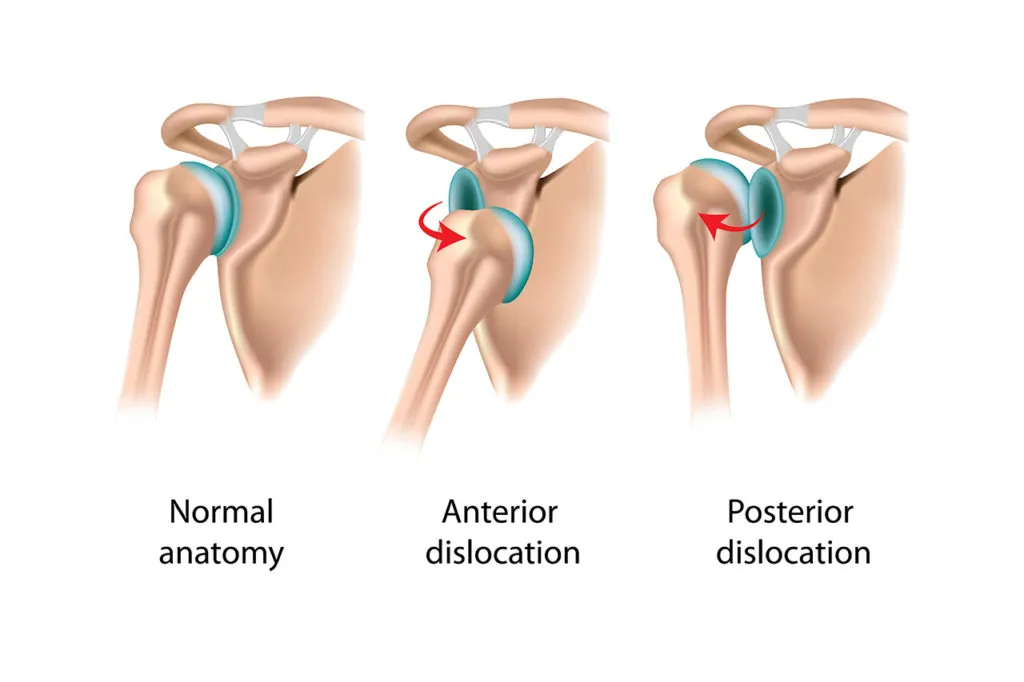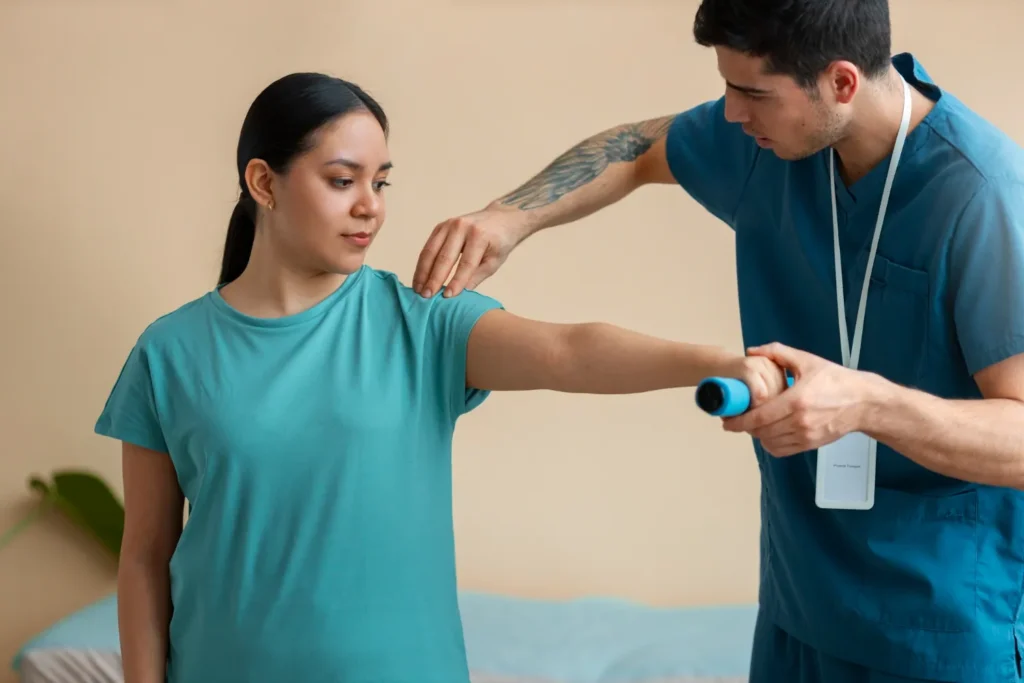Suffering from a dislocated shoulder can be a painful and debilitating experience. But did you know physical therapy can be a game-changer in your recovery? Welcome to our comprehensive guide on physical therapy for dislocated shoulder, where we delve into practical strategies and exercises designed to restore your shoulder’s strength, flexibility, and function.
Whether you’re an athlete, an accident victim, or simply experiencing shoulder pain, this article is your first step toward a pain-free and active lifestyle. Stay with us as we explore the ins and outs of shoulder dislocation and how physical therapy can help you regain mobility and confidence.
What is a Shoulder Dislocation?

A shoulder dislocation occurs when the head of the humerus, or upper arm bone, is forced out of its socket in the shoulder blade, known as the glenoid. This injury can happen for various reasons, such as a fall, a sports injury, or a traumatic impact. The shoulder is one of the most mobile joints in the body, allowing a wide range of motion, but this also makes it more susceptible to dislocation.
When a dislocation occurs, it can be classified into two main types:
Anterior dislocation
Anterior dislocation is the most common type, where the humeral head is displaced forward, often caused by a direct blow or sudden twisting motion.
Posterior dislocation
Posterior dislocation: Less joint; this occurs when the humeral head is pushed backward, typically resulting from seizures or electric shocks.
How Can a Physical Therapist Help?
Experiencing a dislocated shoulder can be both painful and immobilizing. However, engaging in physical therapy for a dislocated shoulder can be a pivotal factor in your rehabilitation journey. A skilled physical therapist can offer a tailored treatment plan that caters to your unique needs and objectives, optimizing your path to recovery. Here’s how physical therapy can be instrumental in your healing process:
- Alleviating Pain: One of the primary goals of physical therapy is to manage pain and inflammation. Techniques such as cold therapy, heat therapy, electrical stimulation, or soft tissue massage can ease discomfort.
- Enhancing Mobility: Regaining your shoulder’s full range of motion is a critical step in your recovery. Your therapist will introduce gentle stretching exercises to improve your shoulder’s flexibility incrementally.
- Building Strength: To stabilize the shoulder joint and prevent future dislocations, strengthening the surrounding muscles is essential. Your physical therapist will develop a targeted exercise regimen to fortify your shoulder, upper arm, and back muscles.
- Restoring Functionality: An essential aspect of physical therapy is helping you return to your daily activities and sports. Your therapist will guide you through exercises that simulate your usual tasks or specific athletic movements, ensuring a safe and effective return to your routine.
- Preventive Education: Your therapist will also provide valuable insights on body mechanics, posture correction, and ergonomic adjustments to safeguard against re-injury. Learning how to perform activities safely is crucial for maintaining shoulder health.
By adhering to a well-rounded physical therapy program, you can accelerate your recovery, reduce the likelihood of re-injury, and confidently resume your regular activities with a more muscular, more resilient shoulder.
What Causes Shoulder Dislocation?
Digging into why shoulder dislocations happen shows a mix of factors that lead to this complex and often challenging injury. Knowing these causes gives us a broader view of how to prevent shoulder dislocation and reduce risks and guides physical therapists in their overall approach to dealing with it.
- Sports: Playing contact sports, like football, rugby, or wrestling, is a big reason for shoulder dislocations. These sports involve a lot of physical contact and hard hits, putting people at a higher risk of getting a shoulder injury. The fast and unpredictable moves in these activities make the shoulder more prone to dislocation.
- Accidents: Besides sports, car crashes and workplace mishaps are significant in causing shoulder dislocations. The sudden and robust impact during accidents can be powerful enough to dislocate the shoulder joint. Because accidents are unpredictable, they highlight the importance of preventing them and focusing on rehabilitation after they happen.
- Falling Down: A seemingly mundane act like falling can have profound consequences for the shoulder joint. When individuals attempt to break a fall with an outstretched hand, the shoulder often absorbs the impact, leading to a dislocation. Falls from various heights or on uneven surfaces can create scenarios where the shoulder is subjected to forces exceeding its capacity, resulting in dislocation.
Shoulder Dislocation Symptoms
Recognizing the subtle signs of a shoulder dislocation is crucial for quick diagnosis and action. The effects of a shoulder dislocation go beyond just physical sensations, affecting a person’s daily life and abilities. Grasping these symptoms is the initial move toward getting timely medical help and starting the journey to recovery.
Visible Deformity
A prominent and immediate sign of a shoulder dislocation is often a visible deformity in the shoulder area. The dislocated shoulder may appear noticeably out of place, with a visible protrusion or displacement of the joint. This visual cue indicates the dislocation and requires urgent medical attention.
Intense Pain
The pain associated with a shoulder dislocation is not just a fleeting discomfort; it is intense and immediate. Individuals often report a sharp, stabbing pain that radiates from the shoulder throughout the arm. The severity of the pain makes even subtle movements excruciating, prompting individuals to limit the use of the affected arm instinctively.
Swelling and Bruising
In the aftermath of a shoulder dislocation, swelling and bruising are common occurrences. The trauma to the joint leads to an inflammatory response, resulting in localized swelling around the shoulder. Additionally, bruising may develop due to the rupture of blood vessels during the dislocation, adding to the visual indicators of the injury.
Inability to Move the Arm
The functionality of the shoulder is significantly compromised following a dislocation. Individuals often experience a notable limitation in moving the affected arm. Lifting or rotating the arm is challenging and painful, underscoring how much the dislocation affects the joint’s movement. Recognizing these symptoms quickly and getting medical help is key for a prompt diagnosis and intervention. Whether it’s through non-invasive methods or surgery, dealing with a shoulder dislocation needs a focused and complete treatment plan.
How to Do the Exercises
Shoulder Flexion (Lying Down)
- Starting Position:
- Lie on a flat surface, such as a mat or bed.
- Keep your legs straight and your arms by your sides.
- Execution:
- Slowly raise your affected arm straight up towards the ceiling.
- Maintain control and avoid rapid or jerky movements.
- Stop when you feel a gentle stretch or mild discomfort, ensuring you stay within a pain-free range of motion.
- Repetitions and Sets:
- Perform 10-15 repetitions for 2-3 sets, gradually increasing as your strength improves.
- Repeat on both arms, even if only one shoulder is affected.
- Tips:
- Engage your core muscles to provide stability.
- Use a rolled-up towel or small cushion under your arm for needed support.
Shoulder Blade Squeeze
- Starting Position:
- Sit or stand with your back straight.
- Relax your shoulders and let your arms hang naturally.
- Execution:
- Squeeze your shoulder blades together by pulling them back and down.
- Focus on activating the muscles between your shoulder blades.
- Hold the squeeze for a few seconds.
- Repetitions and Sets:
- Perform 10-12 repetitions for 2-3 sets.
- Gradually increase the intensity as your shoulder strength improves.
- Tips:
- Maintain a controlled movement without straining your neck.
- Breathe naturally throughout the exercise.
Internal Rotator Strengthening Exercise
- Starting Position:
- Sit or stand with your back straight and shoulders relaxed.
- Hold a resistance band or tubing with both hands before your body.
- Execution:
- Keep your elbows close to your body and rotate your affected arm inward against the resistance.
- Focus on the muscles in the front of your shoulder activating.
- Repetitions and Sets:
- Perform 12-15 repetitions for 2-3 sets.
- Adjust the resistance level based on your comfort and strength.
- Tips:
- Control the movement to avoid excessive strain.
- Gradually increase resistance as you feel more comfortable.
Isometric Shoulder External Rotation
- Starting Position:
- Sit or stand with your back straight.
- Hold a small towel or resistance band with your hands, keeping your elbows bent at a 90-degree angle.
- Execution:
- Without moving your elbows, externally rotate your affected arm outward against the resistance.
- Hold the position for 5-10 seconds, feeling the muscles working.
- Repetitions and Sets:
- Perform 10-12 repetitions for 2-3 sets.
- Adjust the intensity based on your comfort and tolerance.
- Tips:
- Maintain good posture throughout the exercise.
- Focus on the quality of the contraction rather than speed.
Shoulder Abduction (Isometric)
- Starting Position:
- Sit or stand comfortably with your back straight.
- Place your affected arm by your side, palm facing your body.
- Execution:
- Lift your affected arm outward to the side against resistance, stopping when you feel a contraction.
- Hold the position for 5-10 seconds.
- Repetitions and Sets:
- Perform 10-12 repetitions for 2-3 sets.
- Gradually increase the duration of the holds as your strength improves.
- Tips:
- Engage your core muscles to maintain stability.
- Adjust the resistance level based on your comfort.
Wall Push-Ups
- Starting Position:
- Stand facing a wall with your feet shoulder-width apart.
- Place your hands on the wall at shoulder height, slightly wider than shoulder width apart.
- Execution:
- Bend your elbows and lower your chest towards the wall.
- Push back to the starting position, straightening your arms.
- Repetitions and Sets:
- Perform 10-15 repetitions for 2-3 sets.
- Modify the intensity by adjusting the distance between your body and the wall.
- Tips:
- Maintain a straight line from head to heels throughout the exercise.
- Control the movement to engage the shoulder muscles effectively.
Finding the Right Physical Therapist for Your Dislocated Shoulder

Suppose you’re seeking physical therapy for a dislocated shoulder. In that case, it’s crucial to choose a physical therapist who specializes in musculoskeletal conditions and has experience with shoulder injuries. At Innovative Therapy PC, we offer expert physical therapy services tailored to your needs. Our team of certified orthopedic physical therapists has extensive experience treating shoulder dislocations and related injuries, ensuring a personalized and effective recovery journey.
Here’s why Innovative Therapy PC is the ideal choice for your shoulder dislocation recovery:
- Specialized Expertise: Our therapists specialize in orthopedic conditions, focusing on shoulder injuries. We stay updated on the latest rehabilitation techniques and protocols to provide the best care possible.
- Customized Treatment Plans: We understand that each patient’s journey is unique. Our therapists develop individualized treatment plans that address your specific challenges and goals, ensuring a recovery tailored to your needs.
- Collaborative Care: We work closely with your healthcare team, including physicians and surgeons, to ensure a coordinated approach to your treatment. This collaboration enhances the effectiveness of your recovery process.
- Advanced Certifications: Our team includes therapists with advanced certifications, such as Certified Orthopedic Manual Therapists (COMT) and specialists certified by the American Board of Physical Therapy Specialties (ABPTS). This reflects our commitment to excellence in patient care.
For personalized and expert physical therapy for shoulder dislocation, choose Innovative Therapy PC. Contact us today to schedule your consultation and take the first step towards a pain-free and active life.
FAQ More About Physical Therapy For Dislocated Shoulder
Can physical therapy help a dislocated shoulder?
Absolutely! Physical therapy plays a crucial role in helping your shoulder bounce back after a dislocation. It focuses on rebuilding strength, improving flexibility, and enhancing stability.
How long after a shoulder dislocation should you start physical therapy?
The timing can differ, starting when healthcare providers give the green light, often a few days to weeks after the injury.
What exercises are suitable for a dislocated shoulder?
A mix of motion exercises, strength training, and stability drills works well. Physical therapists customize programs to meet individual needs.
What is the fastest way to recover from a dislocated shoulder?
Recovery time can differ, but sticking to the physical therapy plan speeds up healing.
Does a dislocated shoulder ever fully heal?
With the proper care and rehab, many fully recover and return to their usual activities.
Will my shoulder ever be the same after a dislocation?
While some may still feel lingering effects, most can regain almost normal function with committed physical therapy and rehab.
Conclusion – Physical Therapy for Dislocated Shoulder
Dealing with a dislocated shoulder can be a challenging and painful experience. However, with the proper treatment approach, including specialized physical therapy for a dislocated shoulder, you can successfully recover and confidently return to your normal activities. Choosing the right physical therapist is critical to a personalized and effective rehabilitation process. At Innovative Therapy PC, we are committed to providing expert care and support to help you overcome your shoulder injury and regain your strength and mobility. Don’t let a dislocated shoulder hold you back – reach out to us for expert guidance and start your journey to recovery today.






2 Responses